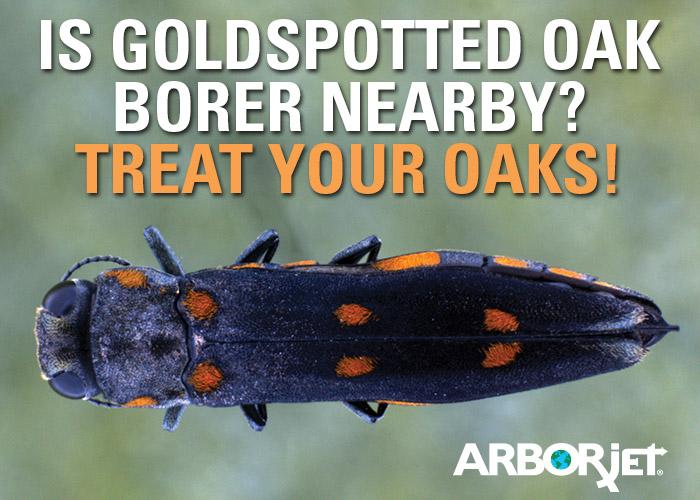The Goldspotted Oak Borer (GSOB) is a flat-headed borer that was originally found around the San Diego, California area. GSOB are currently known to attack three species of oak: coastal live, canyon live, and California black. Adult GSOB are usually 10mm in length and have bullet-shaped black bodies with gold spots on their sides. Oaks with a DBH of 18 inches or above are at the highest risk of dying from a GSOB infestation.
Symptoms of Attack
GSOB attacks can be recognized by extensive bark staining, which can appear as black regions or red blistering with sap oozing from under the bark. Adult exit holes, which are D-shaped and about 1/8” in width, signify previous GSOB attack. On coast live oak, the bark is frequently removed by woodpeckers as they forage for larvae and pupae; this reveals the deep red-colored outer bark that contrasts starkly with the gray exterior bark. The presence of the larvae and their galleries, the emergence holes, and the associated woodpecker damage all distinguish GSOB infestation from infection that causes sudden oak death. The infestation of a tree eventually results in dieback of entire branches and tree mortality.
Treatment with TREE-äge® Insecticide or IMA-jet
TREE-äge and IMA-jet will kill GSOB larvae inside the tree. Treatments should be applied to oaks preventatively, before extensive disruption to the vascular tissues occurs. Dieback symptoms should be less than 40%. Applications should be made in the spring, however, treatment may be applied later in the growing season (July – November) to protect trees.
TREE-äge will kill the GSOB larvae under the bark as well as adult beetles that feed on foliage. TREE-äge is more viscous and may take slightly longer to inject but will provide a longer residual effect of two years control.
IMA-jet will also kill the GSOB larvae under the bark and deter adult feeding in the canopy. A single application of IMA-jet will provide control of GSOB for a full year. The large vasculature in oaks readily move IMA-jet upward into the canopy.
Optimum Soil Conditions
Uptake of formulation is fastest when trees are actively transpiring and soil moisture is good. If the soil is dry, water trees before and after treatment. Consider using NutriRoot™ to enable trees to extract water from the soil, reducing the need for watering, and resulting in faster and better movement of systemic products even in drought conditions. Injections in the fall can protect trees for the following season. Trees need to be closely monitored for symptoms of GSOB as infestations build in your area. In general, applications are not made more than once a year.
If GSOB is Reported Nearby… Treat Now.
Treat oaks immediately if GSOB is reported nearby. Do not wait for visible dieback of canopy, as there is significant delay between disruption to the vascular tissues and expression of symptoms in the canopy. Delaying GSOB treatment could result in canopy dieback or tree loss.
The long term prognosis for trees that are treated before any vascular injury occurs is very good to excellent. Tree recovery from an established infestation is relative to the severity of the infestation at the time of treatment.
Do you have questions about TREE-äge® or IMA-jet? Would you like to speak to a service provider in your area? Contact us!

